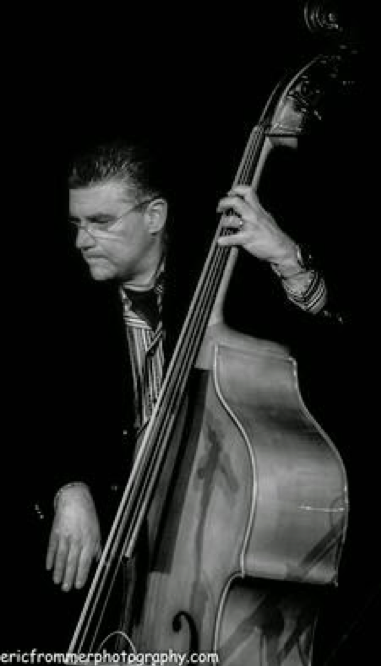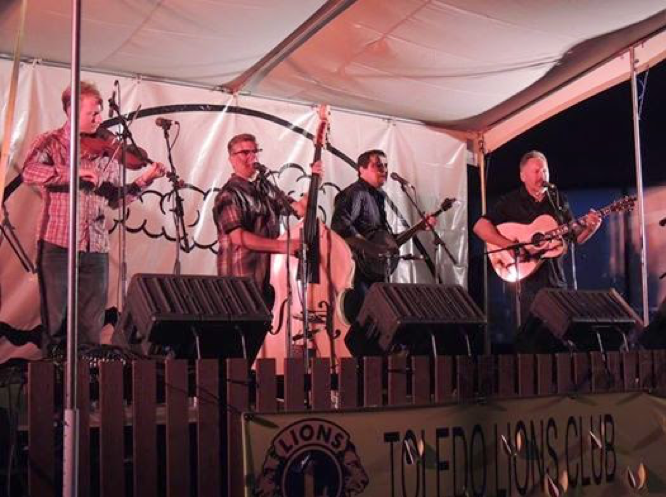The Bluegrass Bass: Wallowing in Root-Five
My particular involvement with the string bass started with the Swamp Opera string band, an Old Time New York City street band from about 1977. I have been playing this lowliest of instruments on and off ever since. In the photo below, I am playing with the Faast and Blair Band in a concert in Washington State sometime during the summer of 2014 (credit to Eric Frommer for the picture).

The bass itself came to country or hillbilly music rather late – ensembles started including it in the early/mid part of the last century. In more recent years, the bass has become just about mandatory in the modern bluegrass setting – our music has evolved to depend on the thumping, low frequency sounds as a pacemaker of sorts that keeps everybody in time.
We will cover a couple of interesting things regarding the bass and bass players in this chapter – I think you will find these items useful whether you are a listener, a bass player or even a person in a band with a bass player. I will use the standup or doghouse bass as the example here, but similar principles apply to electric bass.
Sound production
Basic sound production for bluegrass bass is relatively straightforward (as long as you are sticking with pizzicato or plucking the strings). Bluegrass bassists produce sound with either a “classical” or a “traditional” technique. Classical technique generally produces better tone, but I’ve heard some great sounding traditional bass players too. Some bassists (such as yours truly) will use both techniques – classical for when tone and agility is needed and traditional for when the band wants to do 12 songs back to back in the key of B and the left hand starts to fatigue. You can tell a bass player is using classical technique if they have their left elbow in the air and a serious expression on the face – for example the photo of me earlier in this chapter (queue the deodorant commercial). If they are gripping the neck like a baseball bat and grinning from ear to ear then that is the traditional approach (expect to see a comedy routine too, as these guys are usually pranksters). In the picture below, I am playing with a traditional approach and have a shit-eating grin on my face (hidden by the mic). Photo credit: Clyde Clevenger.

With either technique, the objective is to sound just like Barry Bales, who always produces a big, warm, rich tone that rattles the windows and shakes your haunches.
Timing
This is where the bass player earns every penny of the $10 he will receive in salary at the end of the night. Once the song gets started, the bassist acts with impunity to place where the beat is. Bass notes are easy for anyone to hear, as there are no other instruments competing for sound in that low octave. Further, as anybody who lives in an apartment with a partying neighbor knows, low frequency sounds can penetrate anything (even concrete). This makes the bass the perfect pacemaker for the band: all the other instrumentalists should be able to hear and feel it perfectly well and they need to follow along with it, else suffer the wrath of the bass player. Note that most experienced bass players generally have good timing and are consistently able to place the beginning of each thunderous note right on top-dead-center. Assuming other band members cooperate, this helps considerably to reduce disorder in what otherwise would be a cacophonous situation.
But what about the duration of each bass note? Many bluegrass fans in general and bassists in particular don’t think about that. Next time listen carefully to every bass note. Are they all even in duration or is one note shorter than the other? There is a syndrome that is whispered about in bluegrass circles called “limping bass.” It sounds like this: long/short – long/short – long/short… It is highly contagious and is ruinous to the groove. If everything else is good and you still can’t dance to the music, this is where to look. If your local bass player is infected with this disease and you really want to dance, be sure to address it with him carefully and in private along with a good bottle of single malt.
Root-five
Melody? What melody? Well, Root-five. Sounds like a sporting event? Maybe the road that takes you to the gig? Is it a term from dental school? Nope, it’s none of the above. Root-five is just the sequence of two notes played by a bluegrass bass player at least 90% of the time, over and over, like a broken record. “Root” refers to the note in which a particular chord is rooted and “five” refers to the other bass note that is located five notes above “root[1].” As our title of this chapter suggests, bass players do indeed wallow in root-five and focus on the groove. They don’t need no stinkin’ melody.
Remember the golden rule of good bass playing: when bassists are excelling, nobody notices. They are totally stealth, no ego, and no flash. They wear black clothes and dark sunglasses to all the gigs. They blend in completely with their root-five; nobody in the audience even knows they are there (this leads to widespread insecurity complexes among modern bluegrass bass players and can go a long way in explaining their reclusiveness).
Root-five (90% of the time) is really important to achieve the sound expected in most traditional and contemporary bluegrass music. I can imagine the non-traditionalists rolling their eyes right about now, and yes there are important exceptions to this. For example, Tom Gray did some outstanding and very tasteful work with the Seldom Scene, much of the time deviating from root-five. But generally speaking, bluegrass music is already chock-full of busy-ness and a simplified bass line really helps bring some order to the situation.
What about the 10% of the time the bassist is not root-fiving? Of course, there is the rare bass solo where the bassist steps into the limelight. We will discuss this more below. Other exceptions to the root-five rule include bass runs and a walking bass line, and both of these are also discussed below.
Rhythm
This is the place where the bass player makes huge contributions to the sound. It is where the groove really starts to develop for the band, and the bass is at the absolute center of it. What kind of feel does the song have? Is it driving? Greasy? Peppy? Accomplished bass players will play legato (much more sustain) in greasy or syncopated songs and staccato in peppy tunes. See how much greasy sustain the bassist Ronnie Bowman gets on the Lonesome River Band Recording When You Go Walking and how much it seems to match what is going on with the rest of the band. Contrast that with the recording of Georgia Mail by the same band, which features a more staccato approach. In addition, grace notes are a really cool way to add rhythmic feel to a bass line and are essential for slow and medium speed songs. Go get a recording of Eric Troutman playing bass on I Overlooked an Orchid with Danny Paisley and listen for short ghost notes that anticipate the beat on this slower song. See if you can’t hear the “broken wheel” bass line (making a “pa-boom pa-boom” sound on each revolution):

The “pa” part is the ghost note and is a very short precursor (~ 1/32 note right ahead of the beat) to the “boom” notes.
Slappin’ it around
I feel compelled to write a few words on slap style bass, which is used both in bluegrass and old time. Your bassist can turn heads for hundreds of yards around the jam by slapping his bass – it is a real attention getter. However, just like cooking with spice, it should be used carefully and judiciously. There are three basic slap styles – single, double and triple. Single slap is simply pulling the string hard enough in the vertical direction such that it rebounds onto the fret board with a “snap”. Double slap adds a single front-of-the-hand slap to the string snap. Timing of a double slap is to put the hand slap ½ way between the bass string “snaps” with a straight eighth note time value. Triple slap is a bit more complex and harder to describe in words; briefly it consists of the double slap (above) plus a second quick hand slap. The time value of the string snap is still an eighth note and the hand slaps are two (sometimes swung) sixteenth notes. The resulting sound resembles the fiddle shuffle or “do-dickey-do-dickey-do” kind of pattern (where “do” is the eighth note downbeat / string slap and “dickey” are the two following sixteenth notes as hand slaps). One interesting variation is to switch to slapping “backwards” for a measure or two – reversing the “do” part of the “do-dickey” to be the offbeat and the “dickey” part the downbeat. Your bassist can easily impress friends with this cheap and tasteless maneuver.
Walking and running; 3-walks and 6-walks
Phrasing of bass notes really comes into play during bass runs and fills. Bass runs are the short sequence of notes (usually from a regular scale) that pull the song from one chord to another. They are very useful especially in slow and medium paced songs and can give real motion to a performance. Short bass runs either between chord changes or within a chord can be effective in filling during vocals when other instruments are not.
Walking bass is also a useful tool for a country shuffle. Listen to recordings of Junior Husky back in the day to see how it should be done. Briefly, a walk is where the bass player doubles up the number of notes she is playing – some of the best country walks are referred to as a “three” walk (root-three-five-three-root) and a “six” walk (not as structured as the “three” walk, it uses the notes in the “three” walk plus the addition of a “six” note). Many random Ray Price songs feature a three walk and they really make you want to get out on the dance floor.
Improvisation and soloing
OK I’ll go ahead and state what everybody is thinking and won’t say out loud: Improv is not exactly encouraged for bluegrass bass (or airline pilots for that matter). It can cause ugly crashes. If your bassist wants to improvise in a continuous fashion like the rest of the guys, he should join a jazz band instead. However, maybe the folks in the band are the kind of people that feel sorry for him – the journeyman bassist – reliably carrying the heaviest piece of equipment to each and every gig up and down staircases with no assistance, always holding down the rhythm in an uncluttered fashion, always sticking to root 5 with an occasional run, doing a great job of laying down a great groove 100% of the time and never complaining. Further, he always seems to get blamed for things going wrong (especially speeding up) and never gets any of the credit when the groove is just perfect.
Well, the solution to his now totally bruised and suppressed ego is for his (hopefully empathetic) band mates to give him a bass solo once in a while. Turns out that absolutely anything he plays (even just continuing the root-five pattern while everybody else in the band stops playing) will elicit tremendous applause and admiration from the audience. After all, they didn’t even know he was there the whole set and now all of the sudden there is this new really cool sound that pops out from behind the band all by itself… what is that? THE BASS! Oh look, my gosh, honey, it’s a BASS SOLO! Let’s APPLAUD! This is his chance to improvise… take some risk… play some wild notes… People will clap even if they don’t have a clue what he is trying to accomplish. Of course, it is much better if he pulls off some pyrotechnics that even the Zambelli family would be proud of.
Providing the foundation for a great performance
The very best bass players will make an entire band sound good and raise chill bumps on even the most unenlightened souls. And she will expect absolutely no recognition for the essential contribution, as she is merely the bass player. So, the next time you experience that rush of emotion from a great performance, you should not forget to thank the bass player. It is simply impossible to produce a solid, awe-inspiring bluegrass performance without excellence on the part of the bassist.
One thing worth mentioning to bass players and interested
bystanders in the Internet age is the Talk bass forum (http://www.talkbass.com). This is a great place to get solid
information about bass technique, advice on buying equipment and repairs.
And they do have a bluegrass bass section!
[1] Often this “five” note is played an octave lower, below the “root” note.